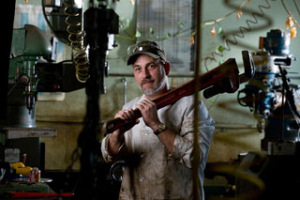Lab machinist one of two in family to supply necessary components for civil lab experiments
The light that’s managed to trickle in through the worn windows of the Y Building has been just enough to keep his father-in-law’s plant thriving for the last two decades.
In the five years since Jeff Miller took over for him as lab machinist supervisor for the college’s department of civil and environmental engineering, green ivy has snaked across doorways, over calipers and micrometers and along railings.
Like the plant’s progressive growth, in his post, Miller has helped department professors and students alike move forward — perfecting methods helping to revolutionize the way we go about our everyday lives.
“No day is ever the same,” said Miller, who has used his years of machining experience and a little trial and error to construct materials needed in department lab experiments. “It can be everything from cutting up concrete to machining steel and aluminum. It’s something different all time. That’s what you love about it.”
It was just a few months after his father-in-law, Martin Kowis, retired that Miller found himself troubleshooting similar puzzles in the same workshop where Kowis had toiled for 20 years.
“My father-in-law talked about the job quite a bit,” Miller said. “Talked about the challenge and how he was always doing something different.”
Sifting through a pile of rough sketches on his desk, Miller offered examples of exactly the challenges he, and Kowis before him, have faced daily on the job.
There was a 4 foot by 2 foot Plexiglas tank Miller built earlier this month for researchers to simulate oil spills. And the brackets for a sensor used to measure wave height and velocity. The anodes no more than an inch in size and a contraption capable of helping researchers, working with the City of Houston, detect leaky pipes scattered throughout the metropolitan area.
“They tell me what they want, but they don’t tell me exactly how to get there,” Miller said pointing to the sketches. “So there’s a lot of problem solving involved with the job.”
The 41-year-old has to have all the factors to ensure what he’s supplying to researchers will work — accounting for things such as chemicals used in experiments that can dissolve glue adhering some projects together.
Aside from work creating materials for lab tests, Miller’s work has impact elsewhere in the department. He not only creates the resources necessary for several demonstrations used in civil engineering classes, but for years has offered his expertise to students competing in the American Society of Civil Engineering‘s annual steel bridge competition.
“I’ll give them instruction on which machine to use for what job and help them set the machine up and show them how to turn it on and off,” he said. “I often get several calls on weekend afternoons.”
In all, Miller said, the job has been rewarding. It’s one that took him from the monotonous routine of his previous work in machine shops and brought him the challenge of creating pieces for researchers bigger visions.
“The thing about machine work is you can spend 20 years on one machine,” he said. “You are working on six or so here, instead of living and dying on that one machine. There’s a good variety and challenge with the job.”
